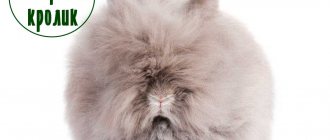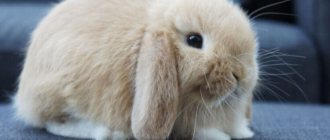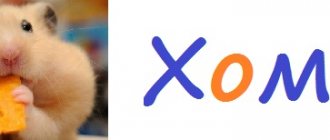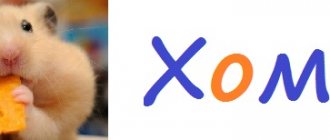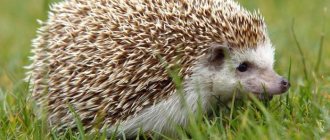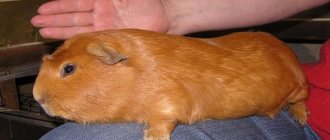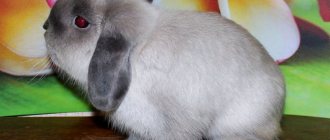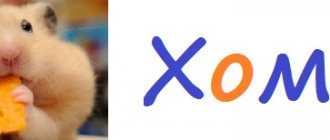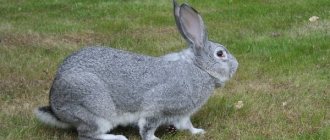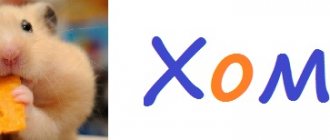Dwarf rabbits are becoming increasingly popular among pet lovers. Smart animals have a friendly character and are easy to care for. The colored rabbit is one of the smallest representatives of its kind and can be kept in a small cage. A variety of animal coat color options allow you to choose a pet to suit every taste.
Description and standards
According to the current breed standard, the weight of an adult animal cannot exceed 1250 g. For home keeping without the purpose of breeding, the permissible weight of an adult is 1.5 kg.
Body Features:
- the body of the animal is short, tightly built;
- tarsi short, well pubescent;
- the head is round, small, set on a short neck;
- The ears are rounded, no more than 5.5 cm long, straight, pressed to each other.
The eyes are large, dark, expressive. In appearance, the rodent resembles a cute plush toy with short thick fur.
The short-haired dwarf rabbit can have any color characteristic of other breeds. The following colors are popular and loved:
- Havana, luxury;
- Russian (ermine), Siamese;
- fiery black, chocolate;
- blue marder;
- squirrel;
- silver, blue, fawn;
- piebald, butterfly.
In colored rabbits, pure white coat color is rare and is highly valued by animal lovers.
History of the breed
The colored dwarf rabbit breed was bred by the German rabbit breeder Hoffmann back in 1938. To obtain it, he crossed an outbred rabbit with the red-eyed Hermelin. Two decades later, at one of the exhibitions in Germany, 24 pets of a new breed were presented, with different colors of blue, Siamese, black, gray, marder, etc.
Hermelin is one of the progenitors of colored dwarf rabbits.
The European breed standard was published in 1992, and 5 years later a modern standard was released with changes made (for example, the minimum allowable weight was increased from 0.6 kg to 1 kg ).
Behavioral characteristics
Thanks to targeted breeding for home keeping and close contact with humans, animals have a calm and docile character. During the selection process, aggressive individuals were discarded.
If you interact and play with your pet every day, and tame it gently and patiently, the colored rabbit will quickly become tame and learn to perform simple funny tricks.
The owner needs to remember that the rodent is curious and shy. If frightened, your pet may bite or scratch with its hind legs. The animal must be protected from stress.
Where to buy and price of baby rabbits
It is best to buy an animal in special nurseries in any large city. There you have the opportunity to look at the baby rabbit and his parents; there is a greater chance that the animal will be healthy and with all the necessary vaccinations. The following nurseries offer rabbits:
- Valley of the Winds, Moscow;
- Rabbit Kuzya, St. Petersburg;
- Ma Zai and Mumi Kroli, Ufa;
- Fairytale country, Rostov-on-Don.
Special clubs also breed rabbits for sale, for example:
- Krol Arthur, St. Petersburg;
- Les lapins MarSi, Moscow.
A dwarf colored rabbit can also be purchased from private breeders through advertisements, although there is a small risk of getting a pet that is not entirely necessary and not entirely healthy. It is also extremely rare to find the desired breed in pet stores, but you can try to order a rabbit by contacting the store owner.
ATTENTION! You definitely shouldn’t buy a decorative dwarf rabbit at the market from random sellers, as they may sell an ordinary baby rabbit instead.
The price of a rabbit depends on the color, pedigree, place of purchase and varies from 900 to 7,000 rubles. for the little rabbit.
Conditions of detention
A baby rabbit purchased at a pet store or from a breeder is placed in a cage measuring 60 by 80 cm. You can purchase a more spacious house or build an enclosure. A pet living in a small home must be allowed to run around.
The cage is placed in a quiet place, away from drafts and radiators. The rabbit house should not be exposed to direct sunlight. Comfortable temperature is 20–22 degrees; colored rabbits do not tolerate heat well.
A vacuum automatic drinker and feeders for vegetables and grain are hung in the cage. It is convenient to place the hay in a special wire ball, from where the rabbit pulls it out in small bunches. Some owners put a tray in the cage where the pet goes to the toilet.
The cage is cleaned weekly using plain, unscented soap as a detergent.
Animals of the colored dwarf breed are not bathed. Once a month, wipe the inside of the ears with a damp cloth. During the molting period, it is necessary to comb your pet with a brush.
Colored dwarf reviews from owners
I wouldn’t have gotten a rabbit myself, I wouldn’t have even thought about it, but my brother gave me this little miracle. At first I was afraid that they wouldn’t get along with the cat, but to my surprise they have been living together for three months now. It is easy to feed the rabbit hay, food, carrots, apples, he loves everything. She even loves cabbage, but I read that it’s better not to give it.
Despite the presence of disadvantages (he chews plants, wooden furniture and wallpaper, I have not yet been able to wean him off), the rabbit still became my favorite. He goes to the toilet in a designated place, but sometimes he manages to shit himself somewhere in the corner. Therefore, I only let him out of the cage when I can keep an eye on him. Anastasia
I was given a rabbit for New Year, about 5 years ago. Then he was tiny, or rather she was a white, beautiful girl. Even then you couldn’t get bored with her; she was active, playful, curious and very nimble. But a coward is afraid of strangers. There were no problems with litter box training; the principle is similar to training cats.
Her diet varies; when I have time, I buy ingredients for food at the market, and when I don’t, I buy ready-made food from the pet store. For greens, she loves green salad and carrots. He never refuses hay either. In addition to feeding, it is important to monitor the water; now my little rabbit drinks a whole water bottle in a day. When I'm at home she walks freely around the apartment, at other times she's locked in a cage.
Rabbits of this breed are playful, mine is definitely so. But we must remember about sharp teeth and claws; if you pester her when she doesn’t want to, you can get back in the form of scratches. Rabbits also like to chew wires, papers and things, so all this should be in inaccessible places. And lastly, these are not the quietest pets, if you are sensitive to noise at night, it is probably better not to get a rabbit. Svetlana
Feeding
For domestic rabbits, special feed mixtures are purchased, which include:
- extruded grain of oats, barley, corn, wheat;
- sunflower seed, flax seed;
- pieces of dried carrots, beets, apples, pumpkins;
- herbal granules.
Ready-made mixtures are enriched with vitamins and minerals. The best manufacturers of food for decorative rabbits are Little On, Vaca, Triol.
The dwarf animal is given 1–1.5 tablespoons of the mixture per day. In addition, the menu includes hay or dried grass, some fresh vegetables and fruits. You should not give your pet food that is overly juicy and fermentable: cabbage, red beets, radishes.
The rodent feels the need to grind down its teeth, so it can ruin furniture and clothing. To avoid this, the pet is given twigs of willow, apple, pear, rowan, and oak to chew on.
Care
In general, colored miniature fluffies have strong natural immunity. To keep your pet healthy, it is enough to get all the necessary vaccines against pasteurellosis, hemorrhagic disease and myxomatosis. and control the quality of his diet.
Be sure to include mineral supplements in your diet. Calcium is very important for rabbits. When it is deficient, dangerous symptoms such as convulsions, heart failure appear, and small rabbits can even die from this.
You should especially carefully monitor such living creatures during the period close to puberty. At this time, animals often behave restlessly and even aggressively. Such aggression can manifest itself both towards other eared animals and towards humans. The pet achieves complete calm only by the age of 1.5 years.
How to choose a rabbit
It is better to buy a pet from reputable pet stores or from trusted breeders. Unscrupulous sellers may slip an ordinary breed rabbit to an inexperienced buyer. Such an animal will also delight its owners, but by 7–8 months it will acquire the size of an adult farm rabbit without any signs of dwarfism.
A purebred animal has accompanying documents - a pedigree and a certificate of received vaccines.
A healthy pet has clean, shiny fur and no discharge from the ears, eyes, or nose. They also pay attention to the behavior of the rabbit - it must be active and mobile.
Features of choosing a breed
You should be extremely careful when purchasing a dwarf rabbit. Quite often, pet store owners sell to inexperienced customers, instead of rabbits, colored dwarfs, young animals of ordinary outbred animals, the cost of which is much lower. And it is possible to recognize the deception only after six months or a year, when the purchased baby catches up in size with the cat.
To avoid this and other unpleasant moments, when choosing, it is important to adhere to certain rules:
- It is advisable to make a purchase in specialized nurseries, and not in regular pet stores.
- The rabbit must be active, constantly on the move. The coat and eyes are shiny.
- You should carefully examine the eyes, nose, and anus for any discharge. If they are present, the animal is unhealthy.
- It is definitely worth checking the condition of the animal’s skin. To do this, pick him up and gently run your finger against the pet’s fur, looking for places of damage and the presence of parasites.
- To determine the character of the animal and whether it is accustomed to being handled, you can pick it up and hold it for a while, constantly stroking it. Calm individuals will not break out.
If all the criteria are normal, you can safely buy the pet. But transporting it home should be done with extreme caution. To do this, use a special carrying cage or a convenient basket. The bottom of such a container is lined with soft cloth or sawdust. Some rabbits are extremely timid and may react restlessly to changes in their surroundings. If you do not use a container, this may lead to injury to the animal.
Colored dwarfs have proven themselves all over the world as one of the cutest pets. The animal has a spectacular appearance and comes in a number of different original colors. In addition, such a baby does not require special care and high maintenance costs. But, in the process of buying a dwarf, it is important to approach the choice extremely carefully in order to purchase a healthy animal with a clear breed affiliation.
Breeding
Animals become sexually mature at the age of 12 weeks, but they cannot be bred earlier than 6 months. The female comes into heat every 20 days, becoming restless and irritable. She is placed in a cage with a male, who carries out the cage.
A rabbit's pregnancy lasts 28–35 days. A week before the expected birth, the females place a nest house in the cage and provide it with hay. The female rabbit herself drags the hay into the house and plucks some fluff to cover her offspring.
From 3 to 7 cubs are born - naked, blind and deaf. The female feeds them with milk for up to 2 months. Already at 18–20 days, the babies open their eyes and begin to leave the nest in search of additional sources of food. From this time on, feed must be supplied 2–3 times more, taking into account its consumption by young animals.
Keeping decorative colored rabbits at home is an easy and fun activity. Communication with a curious and intelligent animal brings joy and helps you relax.
What are the pros and cons?
Among the advantages of this breed are the following:
- no need to wash regularly;
- good-natured character;
- easy to train to the tray;
- not picky about food.
Due to their character traits, such rabbits require constant attention. Animals are prone to mood swings. Like other rabbits, this variety sheds every three months. In addition, animals need a spacious enclosure.
See also
Description of white giant rabbits, rules of keeping and crossingRead
Dwarf rabbit and its varieties
The dwarf rabbit is a cute decorative animal that appeared in our country relatively recently. Over the past decade, he has gained great popularity, as evidenced by numerous photos on the Internet. Small animals are bought for beauty, as living toys for children. They differ from ordinary rabbits in size. Do not confuse decorative and dwarf rabbits. Even large animals can be decorative, but it is not always convenient to keep them in an apartment. Dwarf rabbits, even adults, are tiny in size.
Minilop
And finally, one of the most difficult dwarf species to breed.
The story with the dwarf genes and splitting in this breed is very complicated, we will dwell on it another time in more detail.
It must be said that the ideal weight for a minilop is 1-1.3 kg, when it grows up to 1.6 kg.
The rabbit's body is massive, but compact, the back is round, the neck is not visible.
The head in profile resembles a ball, the eyes are deep-set, the ears droop, which is why the rabbit has a sad expression on its face.
The breed was developed in the Netherlands and is distributed mainly in Europe.
Here you can buy a minilop rabbit for 2000 rubles, an elite one - over 5000 rubles.
The optimal price is 2500-3000 rubles.
Remember that damn important thing at the beginning of the article? So here it is. You really should understand the breeds of not “decorative” rabbits, but dwarf rabbits
Otherwise, you risk buying a mini-pet from an unscrupulous breeder and ending up with some kind of meat giant.
Description of the dwarf rabbit
Dwarf rabbits come in many varieties. They differ in size, length and structure of fur, ear shape, and color. The general characteristics of this variety are its low weight and dimensions, which are much smaller than those of ordinary rabbits. On average, the dwarf species weighs 2-2.5 kg; there are breeds from 0.7 kg to 3 kg. The length ranges from 30-35 cm, and the chest girth is 20-22 cm, depending on the breed.
There are species with straight and drooping ears. The latter are called rabbits and rams. On average, the ears of miniature rabbits are 5-6 cm long; those of rams are longer, can reach 20 cm. Accordingly, the weight of such rabbits is greater, about 2.5-3 kg. Based on the length of their fur, dwarf rabbits are divided into:
- Shorthair (hair length 15-20 mm)
- Medium-haired (hair length – 20-40 mm)
- Long-haired (hair length more than 50 mm)
The structure of wool varies. Satin and Angora fur are especially prized, as is the plush fur of the Rex breed. The average lifespan of a pet is 5-7 years. Proper care and maintenance of a dwarf rabbit can extend it by 2-3 years. Long-living record holders live in the homes of their owners for 10-12 years. Neutered animals live longer.

